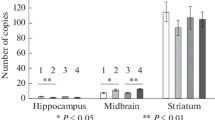Seasonal depressive disorder occurs in conditions of seasonal reductions in the duration of daylight and is a significant medical, social, and economic problem. The risk of seasonal depressive disorders is linked with impairments to the serotonin system of the brain. Tryptophan hydroxylase 2 (TPH2) is the key enzyme in serotonin synthesis in the brain. The C1473G polymorphism in the gene encoding TPH2 in mice leads to a twofold decrease in the activity of this enzyme in the mouse brain. The aim of the present work was to study the effects of the length of daylight on the behavior of mature males of the congenic strains B6-1473C and B6-1473G, which have high and low levels of TPH2 activity, respectively. Adult males of these strains were kept for one month in conditions of long (14 h) or short (4 h) daylight durations. Being kept in conditions of short daylight had no effect on mean day-round movement activity, food and water consumption, or anxiety in the open field and elevated plus maze tests in either mouse strain, but decreased mean sleep duration (p < 0.002) and active resistance in the forced swimming test (p < 0.01), changes being similar in both strains. Thus, the C1743G polymorphism had no effect on changes in behavior induced in mice by short daylight.
Similar content being viewed by others
References
Bains, R. S., Wells, S, Sillito, R. R., et al., “Assessing mouse behaviour throughout the light/dark cycle using automated in-cage analysis tools,” J. Neurosci. Meth . (2017), pii: S0165-0270(17)30113-9, doi https://doi.org/10.1016/j.jneumeth.2017.04.014.
Barkus, C., “Genetic mouse models of depression,” Curr. Top. Behav. Neurosci., 14, 55–78 (2013).
Bazhenova, E. Y., Bazovkina, D. V., Kulikova, E. A., et al., “C1473G polymorphism in mouse tryptophan hydroxylase-2 gene in the regulation of the reaction to emotional stress,” Neurosci. Lett., 640, 105–110 (2017).
Bazovkina, D. V., Lichman, D. V., and Kulikov A. V., “The C1473G polymorphism in the Tryptophan hydroxylase-2 gene: involvement in ethanol-related behavior in mice,” Neurosci. Lett., 589, 79–82 (2015).
Bourin, M., “Animal models for screening anxiolytic-like drugs: a perspective,” Dialogues Clin. Neurosci., 17, 295–303 (2015).
Ennaceur, A. and Chazot P. L., “Preclinical animal anxiety research - flaws and prejudices,” Pharmacol. Res. Perspect., 4, e00223 (2016).
Fisher, S. P., Godinho, S. I., Pothecary, C. A., et al., “Rapid assessment of sleep-wake behavior in mice,” J. Biol. Rhythms, 27, 48–58 (2012).
Kulikov, A. V., Osipova, D. V., Naumenko, V. S., and Popova N. K., “Association between Tph2 gene polymorphism, brain tryptophan hydroxylase activity and aggressiveness in mouse strains,” Genes Brain Behav., 4, No. 8, 482–485 (2005).
Kulikov, A. V. and Popova N. K., “Tryptophan hydroxylase 2 in seasonal affective disorder: underestimated perspectives?” Rev. Neurosci., 26, No. 6, 679–690 (2015).
Kulikov, V. A., Khotskin, N. V., Nikitin, S. V., et al., “Application of 3-D imaging sensor for tracking minipigs in the open field test,” J. Neurosci. Meth ., 235, 219–225 (2014).
Lesch, K. P., Araragi, N., Waider, J., et al., “Targeting brain serotonin synthesis: insights into neurodevelopmental disorders with long-term outcomes related to negative emotionality, aggression and antisocial behavior,” Philos. Trans. R. Soc. Lond. B Biol. Sci., 367, 2426–2443 (2012).
Levitan R. D., “The chronobiology and neurobiology of winter seasonal affective disorder,” Dialog. Clin. Neurosci., 9, No. 3, 315–324 (2007).
Miller A. L., “Epidemiology, etiology, and natural treatment of seasonal affective disorder,” Altern. Med. Rev., 10, No. 1, 5–13 (2005).
Monti J. M., “Serotonin control of sleep-wake behavior,” Sleep Med. Rev., 15, 269–281 (2011).
Nikulina, E. M., Skrinskaya, J. A., and Popova N. K., “Role of genotype and dopamine receptors in behaviour of inbred mice in a forced swimming test,” Psychopharmacology (Berl.), 105, No. 4, 525–529 (1991).
Otsuka, T., Kawai, M., Togo, Y., et al., “Photoperiodic responses of depression-like behavior, the brain serotonergic system, and peripheral metabolism in laboratory mice,” Psychoneuroendocrinology, 40, 37–47 (2014).
Overstreet, D. H., “Modeling depression in animal models,” Meth. Mol. Biol., 829, 125–144 (2012).
Pack, A. I., Galante, R. J., Maislin, G., et al., “Novel method for high-throughput phenotyping of sleep in mice,” Physiol. Genom., 28, 232–238 (2007).
Ramaker, M. J. and Dulawa S. C., “Identifying fast-onset antidepressants using rodent models,” Mol. Psychiatry, 22, 656–665 (2017).
Siesser, W. B., Zhang, X., Jacobsen, J. P. R., et al., “Tryptophan hydroxylase 2 genotype determines brain serotonin synthesis but not tissue content in C57Bl/6J and BALB/cJ congenic mice,” Neurosci. Lett., 481, 6–11 (2010).
Treit, D., Engin, E., and McEown, K., “Animal models of anxiety and anxiolytic drug action,” Curr. Top. Behav. Neurosci., 2, 121–160 (2010).
Waider, J., Araragi, N., Gutknecht, L., and Lesch K. P., “Tryptophan hydroxylase-2 (TPH2) in disorders of cognitive control and emotion regulation: a perspective,” Psychoneuroendocrinology, 36, 393–405 (2011).
Walther, D. J., Peter, J. U., Bashammakh, S., et al., “Synthesis of serotonin by a second tryptophan hydroxylase isoform,” Science, 299, 76 (2003).
Willner, P., “Animal models of depression: an overview,” Pharmacol. Ther., 45, 425–455 (1990).
Zhang, X., Beaulieu, J. M., Sotnikova, T. D., et al., “Tryptophan hydroxylase-2 controls brain serotonin synthesis,” Science, 305, 217 (2004).
Zhang, X., Gainetdinov, R. R., Beaulieu, J. M., et al., “Loss-of-function mutation in tryptophan hydroxylase-2 identified in unipolar major depression,” Neuron, 45, 11–16 (2005).
Zhang, X., Nicholls, P. J., Laje, G., et al., “A functional alternative splicing mutation in human tryptophan hydroxylase-2,” Mol. Psychiatry, 16, 1169–1176 (2011).
Author information
Authors and Affiliations
Corresponding author
Additional information
Translated from Zhurnal Vysshei Nervnoi Deyatel’nosti imeni I. P. Pavlova, Vol. 69, No. 1, pp. 78–87, January–February, 2019.
Rights and permissions
About this article
Cite this article
Khotskin, N.V., Bajenova, E.Y., Kulikova, E.A. et al. Effects of the C1473G Polymorphism in the Tryptophan Hydroxylase 2 Gene and the Length of Daylight on Behavior in Mice. Neurosci Behav Physi 50, 192–198 (2020). https://doi.org/10.1007/s11055-019-00887-w
Received:
Revised:
Accepted:
Published:
Issue Date:
DOI: https://doi.org/10.1007/s11055-019-00887-w



